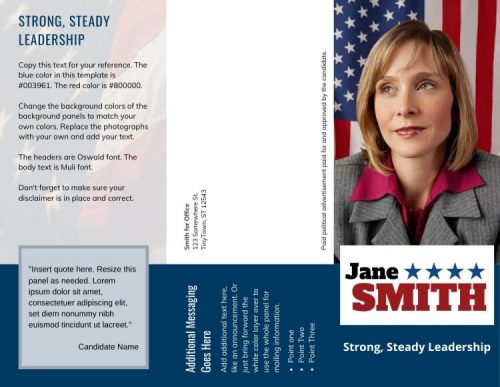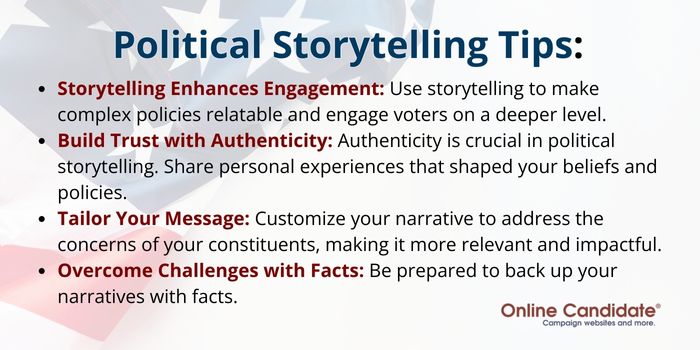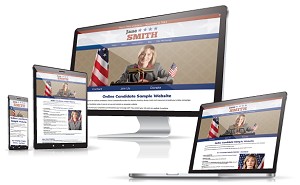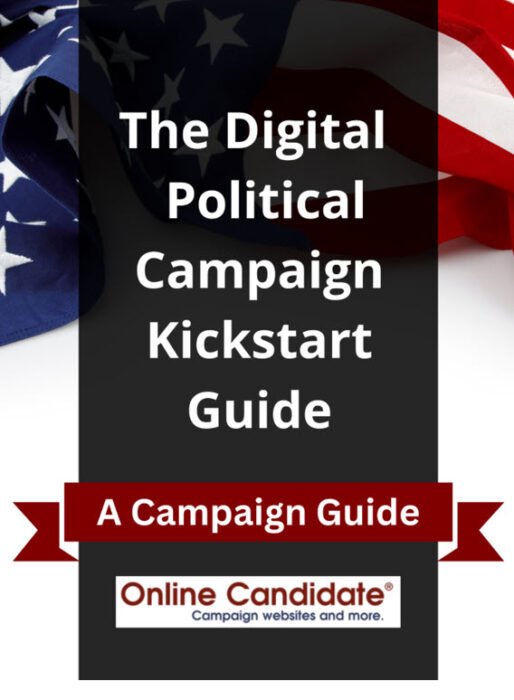Political Campaign Slogan Ideas for Candidates
A political campaign slogan is a short phrase that best identifies a candidate and their candidacy. It should capture a voter’s attention and address their concerns and issues. Campaign slogans should also be memorable and concise.
The best slogans in politics are both positive and suggest action. They should be easy for voters to remember, emphasize a message, and connect on an emotional level.
Easy to do, right?
It doesn’t matter if you are running for mayor, sheriff, school board, city council, county, town, state legislature, or even Congress. The slogan you choose should represent the essence of your message to voters.
But which one is right for you? Here are over 100 examples to inspire anyone starting a run for office.
Running for Office: Subscribe for free tips and updates.
Campaign slogan ideas for mayor and city council candidates
These popular slogans work for all types of elections. Many of them deal with promising results, improving the future, or making change. The examples listed below work well for local elections that involve a mayor, town board, county official, alderman, and city council races. They are also suitable for state representative candidates, governors, and even federal election campaigns for the US Senate and House of Representatives.
- [Name] for reform. [Name] for action.
- A Voice for You
- It’s Time for a Change
- Let’s Make a Difference!
- Vote [Name] for Change
- Working for YOU!
- Voting for a Brighter Tomorrow
- Promises made, promises kept.
- Integrity. Honesty. Commitment. [Any combination]
- Strength and Experience.
- Taking Action, Getting Results.
- For a Better [town/city/village]
- Make Your Voice Heard
- A Voice for [Smart Growth/Lower Taxes/Etc.]
- Had Enough? [I Have.]
- Proven [Leadership/Tax Cutter]
- Make the City Work for People Again
- Cleaning up [Location]
- A Real Choice for [Location]
- Vote for [Leadership]. Vote for [Change].
- The Choice is Clear.
- A Record of Accomplishment
- Independent Leadership
- Fighting for [Location]’s families
- For Effective Government
- Working harder for [Location]
- A Fresh Voice
- A Candidate For The People
- Government with Integrity
- Leadership for [Location]
- Vote [name] for Results and Accountability
- Dedicated, Proven Leadership
- The Change We Need
- Experience and Integrity. Vote for Me.
- Rebuild and Restore our Community
- Your Voice for Positive Change.
- Protecting Your Tax Dollars
- Right Time, Right Choice.
- New Leadership for a Better [Location]
- Leadership Through Innovation
- Vote for a Better Tomorrow
- Standing Up For What’s Right
- A Qualified Voice For [Location]
- [Name] for [Position] … for [Location]’s future.
- A Common-Sense Leader to Change [Location]
- Working Together, For Change
- Your Vote is Your Voice
- Keep the Progress Moving
Punctuation can change the meaning of text. There’s a big difference between using an exclamation point and a question mark (Like Jeb!). You can use a period to emphasize the statement. For social media, a slogan should be hashtag-friendly. Tools like alliteration or rhyme are often used to help them stick in the public’s memory.
In fact, some politicians really have a tough time choosing one.

Your slogan should be displayed on promotional brochures and signs.
Sheriff Slogans – Strength and Character
- Honesty, Integrity and Character
- Your Safety First
- Law Enforcement You Can Trust
- Community Changes Everything
- The New Sheriff In Town
- New Leadership For A Safe [Location]
- Qualified and Experienced
- Protecting the Public
- Safety, Service, and Security
- Bringing Accountability Back to the Badge
- Your Voice, Your Sheriff
- Policing with Heart and Honor
- Putting Citizens Before Politics
- More sheriff slogans.
Sheriff elections typically rely on reminding voters of their strength or personal character. They often reference community and are often used as taglines for yard signs and logos. Some of these examples can also be used for district attorney candidates.
Judicial Candidate Slogans – Experience and Integrity
Candidates for judge typically create slogans that emphasize their judicial temperament and personal integrity. (The same goes for district attorney candidates.) These races tend to be non-partisan, which is why a slogan for a judicial candidate tends to be more personal in nature. Judges don’t run on specific policies when reaching out to voters; that’s what the politicians do.
- Justice for YOU
- Integrity. Honesty. Commitment.
- Experience Counts
- Dedicated to Justice
- Hardworking, Experienced, Fair
- Justice for YOU
- Experience We Need
- Proven Experience and Integrity
- Integrity for the Bench
- More judicial slogan ideas.
Slogans for School Board Races – What’s the Issue?
A school board election slogan usually involve a current issue effecting the district or the local board of education. In the end, it’s all about the children.
- Better Schools For A Better Tomorrow
- Working for a Better Classroom
- Academic Excellence Today
- Putting Students First
- For a Better Future
- Make our Schools Great
- Better Schools, Better Children
- Education and Progress
- Building a Brighter Educational Future
- Empowering the Next Generation
- More school board slogans.

Is Being Funny Worth the Risk?
Funny or humorous messaging will often get attention in politics. However, while humor can grab attention, be careful. This tactic can backfire if it’s perceived as tone-deaf or insensitive, You run the risk of voters not taking you seriously. It’s also possible that some people will take a joke the wrong way and be insulted by your attempt at humor.
- Don’t pick your nose, pick [Name]
- With great power comes great responsibility (from Spider-Man)
- If you must waste your vote, waste it on me
- I think, therefore I am voting for [Name]
- Be a pal, vote for this gal
- I’ll do my best, but I can’t promise anything
- In this election … You can’t do worse
- You’ve tried the rest, now choose the best
Here are some more funny examples.
How to Come up with a Great Slogan
Political slogans that are short and memorable work best. Forget weak and passive phrasing. Start by answering a few questions:
- What is your motivation for running for office?
- Do you have a core value or issue you are trying to impress on voters?
- Is there something specific that you want voters to know?
- What is important to your community?
- Does your messaging relate to you being a Democrat, a Republican, or running on a third-party ticket?
If you are going to recycle a tagline from another candidate, you will, by association, take on the good and bad of that previous use. You might want to do a little research first.
There have been instances where a candidate has taken a political opponent’s message. In one race, the same tagline was used on promotional material by two candidates in a judicial primary. There were allegations of voter confusion, defamation, and theft. Considering how much of a distraction plagiarism can become, it’s best not to swipe material. And you should never adopt the messaging of your opposition. Nor should you use copyrighted material (visual or text). That will get you in trouble.
Changing a slogan during a campaign
Altering your brand identity, such as your slogan, while campaigning can cause confusion among your supporters and voters. It raises the risk that you will be perceived as inconsistent. On top of that, you’ll have to update all of your advertising, brochures, signs and print materials.
If you need to make a change in your messaging, do it as early as possible.
Found the right slogan? Great! Now use it on all of your election campaign materials, from signs to mailers to your campaign website. It should remain consistent and endure throughout the season, right through Election Day.
Related: Political Slogan Generator
Build your campaign website with Online Candidate. With four affordable packages and upgrade options, which services are right for you?
Political Campaigns Aren’t Won By Part-Timers
We get it. You likely have a full-time job that keeps you busy. And depending on the elected position and the circumstances of your race, you may not need to run a 24/7 campaign.
But if you are going to run for office, you need to understand what you are getting into. Political campaigning requires a real commitment that will challenge and change your daily life for the foreseeable future. Whether you are running for town council or state representative, you’ll need to put in the work to win.
Even if your time is limited, your campaign will require as much effort as you can give.
Because no candidate ever won an election by doing too little.
The Time Commitment of Political Campaigns
Picture your calendar packed with activities like door-to-door canvassing, tireless fundraising events, and intense strategy meetings, along with public rallies and private appearances. This isn’t just the routine for state or congressional races; even highly-contested local elections can demand a huge level of engagement.
And that can be tough if you are employed.
Some prospective candidates assume that simply announcing their candidacy—essentially ‘throwing their hat in the ring’—is all they need to do. However, getting on the ballot is only the beginning. It also marks the start of an emotionally taxing period of public scrutiny and personal criticism.
There are three major tasks that will require attention:
- Fundraising: Remember the old telephone ad, “Reach out and touch someone?” That’s what you’ll need to do if you want to have donors. Fundraising is more than just sending emails and letters asking people for money. You’ll need to build and leverage relationships with donors, especially the more generous ones. This involves phone calls, meetings, and events, making fundraising an ongoing and time-consuming task. Hosting a fundraising dinner might require weeks of preparation, securing a venue, and inviting potential donors. During the event, you’ll need to engage with attendees and make a case for their support.
- Canvassing and Connecting: Especially for local races, door-to-door canvassing is a great way to connect with constituents. You’ll definitely hear some stories from the people you visit, which can be both inspiring and draining. Even if you’re a fast walker and you have other volunteers helping, canvassing takes a lot of time. Expect to spend several evenings and weekends walking neighborhoods. You’ll talk to residents, listen to their concerns, and gather support. The benefits are more exposure and increased voter turnout, especially if your election date is not widely advertised.
- Strategy and Adaptation: Political strategy is not set in stone. It evolves in keeping with current events, examining voter feedback, and keeping tabs on your opponent’s moves. Staying relevant requires daily involvement and close coordination with your campaign team. If a local issue becomes prominent, you might need to quickly shift focus. This could mean quick strategy meetings and new campaign material creation, all while keeping your core message consistent. You have to adapt quickly to stay relevant and effective. Staying on top of your campaign requires daily involvement and coordination with your campaign team.
These tasks form the core of your campaign. They’re not just chores that can be put off to the spare hours of your evenings or weekends. You need to always be on your toes, responsive, and energetically involved with all the time you have available.
Every handshake, every conversation, and every contact is important. You have time constraints both on the calendar and in the hours of the day.
There’s a reason they’re called races.

You can’t snooze your way through the election season.
The Drawbacks of Being a Weekend Campaigner
If you’re only engaging in campaign activities on weekends or the occasional evening, you’re missing out. Your opponents are likely putting in more time and getting things done.
What will they be doing?
- They’ll be making more connections.
- Raising more money.
- They’ll be spending time refining their strategies.
- And be seen more regularly by voters.
A half-hearted effort will put you at a disadvantage. Look at successful politicians. They didn’t win by phoning it in. They immersed themselves in the process. They understood that every interaction and every decision mattered. If your opponent attends a weekday community event and you don’t, they gain visibility and potential votes that you miss out on.
Think about your supporters, donors, and the party that’s backing you. They invest time, money, and advocacy on your behalf. They deserve your full commitment.
Anything less can seem disrespectful. You owe everyone your best effort.
The Cost of Lazy Campaigning
There are many who failed because they didn’t fully commit. Many years ago, we worked on a local race where three candidates ran together as a ‘slate’ for seats on the town board. One candidate only agreed to appear on the ballot because he was asked. He was not particularly invested from the beginning, and it showed.
He didn’t attend many events or strategy meetings. He did little or no canvassing. The amount of money that was raised through his efforts was negligible.
Basically, all he contributed was allowing himself to be included in the advertising, the print ads, and the website for the campaign.
In fact, late that August, when the campaign was gearing up, he went away on vacation. As you can imagine, that didn’t go well with the other candidates. They were furious.
So, what happened?
Obviously, the candidate’s personal campaign lacked momentum and visibility. He basically ran on the coattails of the slate while contributing little personally. Of the three that ran, the candidate who barely participated was the only one who lost.
Commit Fully or Reconsider
Go big, or go home. If you’re at the crossroads of committing to run, consider the dedication, time, and energy you’ll need to win. If you’re not ready to commit fully, it might be wise to reconsider.
After all, those who will support you and your future constituents deserve your best effort. Go give it to them!
Mastering Political Storytelling: Your Secret Campaign Weapon
If this is your first campaign for political office, there’s one tool you absolutely need to use: political storytelling.
A smart politician knows that most voters remember stories and narratives, not facts and figures. Connections are not made by listing policies. Instead, great messaging is delivered through effective political storytelling techniques.
In this article, we explain how the art of storytelling can help set your vision and enhance your campaign.
The Benefits of Storytelling in Your Campaign
Let’s examine how an interesting narrative might enhance your campaign’s strategies.
- Enhanced Voter Engagement: By using storytelling, you can more deeply engage voters by making complex policies more vivid and easier to understand.
- Building Trust and Credibility: Effective storytelling helps establish trust and credibility, as personal stories often resonate more than abstract policies.
- Differentiation from Opponents: A good story and anecdotes can help separate you from your opponents both with voters and the media.
- Emotional Resonance: Want to win more support and loyalty? Good storytelling techniques tap into the emotions of the electorate.
- Memorability: A well-told story will leave your message in voters’ minds long after they’ve heard it.
- Greater Shareability: Compelling narratives are more likely to be shared on social media, expanding your campaign’s reach organically.
The Why and How of Storytelling in Political Campaigns
So, why does storytelling work in political campaigns? It’s rooted in human psychology. Stories stick in our minds because they create real emotion and bonds between the teller and the listener. Research shows that narratives activate multiple areas of the brain, increasing retention and emotional connection.
Consider Barack Obama’s 2008 “Yes We Can” slogan. The hope and change narrative connected with millions of supporters.
Historically, political leaders who mastered storytelling techniques often swayed the public. Franklin D. Roosevelt’s fireside chats during the Great Depression are a classic example. They were radio speeches, but more. The chats made suffering Americans feel like he was actually speaking with them and sharing in their struggles.
Successful politicians often strike a balance between facts and emotion. For example, Alexandria Ocasio-Cortez often shares her background as a waitress prior to becoming a member of Congress. She combines her personal background with policy proposals. Her stories reflect the common struggles of many of her working-class constituents. Because of this, many see in her a reflection of their own experiences.
Ronald Reagan was well known for his stories and anecdotes. He often referenced the idea of America as a “shining city upon a hill.” Derived from a speech by John Winthrop, this phrase emphasized Reagan’s belief in American exceptionalism and the country’s potential to be a beacon of hope and freedom for the world. With this, Reagan painted a picture to voters that the United States was a unique and exceptional nation.

Crafting Your Narrative Through Authenticity
Any story you tell needs to be authentic. Voters can smell insincerity a mile away, and the media may check into any claims you make. Reflect on your experiences and how they shaped your beliefs and policies. The most powerful campaign narratives are rooted in truth, personal growth, and relatable struggles.
For example, if you are seeking a school board seat, share your journey as a public school teacher or as a parent of a student. For example, when explaining why you’re seeking office, you could say:
- “I’ve known what it’s like to face financial uncertainty and job loss firsthand. That’s why I’m running for city council—to create economic stability and opportunities for all, so no one has to go through what my family and I endured.”
- “I’ve seen the flaws in our criminal justice system up close. Whether as a victim, advocate, or someone affected by incarceration, I’ve witnessed the need for reform. I’m running for sheriff to ensure that our justice system works for everyone, regardless of their background or circumstances.”
- “As a parent, I see firsthand the value of quality education. I understand the concerns of today’s students. I’m running for local school board to ensure that our district prioritizes student success and provide equal opportunities for all.”
Tailor your story to the specific concerns of your constituents. Your personal story should ideally address the concerns of your constituents. For example, if you’re running in a district with a strong focus on agriculture, weave in how your policies will directly impact and improve the farming community.
Tailoring Your Message and Breaking it Down
You are not going to be able to repeat your entire history constantly. Because of this, you’ll want to take your greater story and break it down into anecdotes, memorable quotes, and even relatable humor.
- Memorize key anecdotes, as you’ll be using them on the campaign trail over and over.
- Keep your stories concise and easy to follow. Avoid unnecessary details that might distract from the main point.
- Craft impactful quotes that are short, relevant, and emotionally resonant.
Your anecdotes and quotes should seamlessly fit into your speeches, fundraising drives, and campaign materials. They should reinforce your key messages without feeling forced.
Overcoming Storytelling Challenges
In an era of fake news and negative campaigning, skepticism is high. Be prepared to back up your statements and narratives with facts. When challenged, respond with grace, evidence, and confidence.
Some ways to fight back include:
- Highlighting your strengths and continuing to showcase your vision.
- Educating your audience when misinformation spreads.
- Crafting a counter-narrative that addresses negativity without perpetuating it. For instance, if attacked on a policy issue, respond with the benefits of your approach.
Be adaptable as political landscapes change rapidly. Your core story—rooted in your values and beliefs—should remain consistent, but be flexible in your messaging.
Stay true to your core message, and don’t get lost in the noise.
Elevating Your Online Presence with Stories
When it comes to your campaign’s digital strategy, one place that is ripe for storytelling techniques is your political campaign website. Here are ideas of where and how to effectively weave stories into your political campaign website.
- Homepage Narrative: Use your homepage to introduce your core narrative. This sets the tone for what voters can expect from your campaign.
- About Page Storytelling: Your about page is the perfect place for a detailed personal story. Connect your life experiences to your political aspirations and policy stances.
- Blog Posts: Regular blog posts that incorporate storytelling can keep your audience engaged. For example, share experiences of people you’ve met on the campaign trail.
- Testimonials Section: Featuring stories from supporters or beneficiaries of your policies can provide social proof and add a layer of authenticity to your campaign.
- Issue Pages: On pages where you discuss specific issues, include short anecdotes or stories that highlight why these issues matter to you personally and to your constituents.
Using compelling narratives on your website offers many benefits, including:
- Increased Time Spent on Site: Engaging content encourages them to spend more time exploring your site.
- Enhanced Emotional Connection: Stories can evoke emotions, creating a deeper bond between you and your potential voters.
- Improved Message Retention: Information wrapped in a narrative is more likely to be remembered than plain facts.
- Boosted Search Rankings: Well-structured, keyword-optimized stories can improve your site’s visibility.
Conclusion: Storytelling is Your Secret Weapon
Storytelling isn’t just a tool—it’s your campaign’s secret weapon. Let your personal story shine through in every speech, every policy, and every engagement. Make it the central pillar of your campaign’s communication strategy.
Tactics for Conducting Digital Political Opposition Research
In political campaigns, opposition research has moved from the paper archives of the past to online, digital data. Even for local political candidates, political opposition research and campaign intelligence analysis can give you a clear advantage.
This guide provides a blueprint for effective political competitor analysis. If you don’t learn about who and what you are up against, how can you campaign against it?
Highlights:
- Explore effective digital opposition research tools and platforms for first-time political candidates.
- Strategies for analyzing and using opposition research data.
- Learn techniques for discovering and archiving campaign research.
- Ethical standards and legal compliance you need to follow.
- Understanding the importance of adaptability as circumstances change.

Understanding Political Opposition Research
When running for political office, political adversary research is about gathering information about political rivals. This research covers a wide range of areas, including:
- Political background: Learn and understand your opponent’s political history. What offices have they held, what primary and general election difficulties did they face, and so on.
- Voting records: Analyzing how they’ve voted on key issues. Have they changed positions, and why? This is a key to effective opponent policy analysis.
- Public statements: Tracking speeches, interviews, and public communications.
- Campaign strategies: Studying their past and current approaches to campaigning. Did they focus on specific advertising or voter type?
- Personal background: Looking into their educational and professional history, where relevant to their political stance.
The goal is to build a comprehensive picture of your opponents, both professionally and, where relevant, personally. Or to quote Sun Tsu: “If you know the enemy and know yourself, you need not fear the result of a hundred battles.”
The Main Objectives of Opposition Research
Election opponent profiling serves several key objectives:
- Informing Strategy: It guides your campaign’s strategic decisions.
- Issue Identification: It helps identify critical issues and how your opponents have addressed them.
- Preparation: It prepares you for debates and public appearances by knowing potential arguments and counterpoints.
- Message Development: It aids in developing a clear and targeted campaign message.
| Aspect | Purpose | Tools/Methods | Considerations |
|---|---|---|---|
| Background Research | Understanding the opponent’s political and personal history | Search engines, social media platforms, news archives | Respect for privacy, accuracy |
| Voting Records and Public Statements | Analyzing political positions and public communications | Political databases, news archives | Fact-checking, legal compliance |
| Campaign Analysis | Studying campaign strategies and materials | Campaign websites, social media, public records | Ethical campaigning, message consistency |
| Legal and Ethical Standards | Ensuring research adheres to legal and ethical guidelines | Legal advisories, ethical guidelines | Compliance with election laws, positive messaging |
| Strategy Development | Turning data into actionable insights for the campaign | Sentiment analysis tools, network analysis | Adaptability, targeted messaging |
| Archiving | Preserving research data for future reference | Screenshot tools, document scanning apps, video recording | Organized storage, regular updates |
How Can Oppo Research Help Your Campaign?
Campaign reconnaissance plays a pivotal role in political strategy development and execution. It can start even before you start active election campaigning.
- Strategic Planning: Understanding your opponents is necessary for developing your campaign strategy. It dictates where to focus your efforts.
- Targeted Messaging: Tailoring your message becomes a lot easier when you know your opponent’s weaknesses and strengths.
- Voter Engagement: Knowing all sides helps address the concerns and questions of voters more effectively.
- Crisis Management: Being aware of potential opposition attacks or criticisms helps in preparing responses and managing crises.
During the 2004 U.S. presidential election, John Kerry, the Democratic nominee, faced a campaign by “Swift Boat Veterans for Truth,” a group that challenged his Vietnam War record. This opposition research campaign damaged the public’s perception of Kerry. It’s often credited as a large factor in the re-election of George W. Bush.
Strategy Development
Once you have gathered comprehensive information about your opponents, the next step is to turn raw data into actionable insights.
- Identify Key Themes: Look for recurring themes in your opponent’s history and public statements.
- Strengths and Weaknesses: Analyze both your strengths and your opponents’ weaknesses.
- Adaptability: Be prepared to adjust your strategies as new information comes to light. Opposition research is never a one-and-done.
In the 2012 U.S. presidential election, a significant piece of opposition research was prepared by a Republican operative against Mitt Romney, the Republican nominee. This dossier was initially prepared for use in the primary campaigns but was later reportedly used by the Democratic campaign, highlighting Romney’s career at Bain Capital and framing him as someone who profits from the failure of others.
Breaking down the information into actionable parts is the essence of strategy development. This approach helps your campaign remain responsive, focused, and effective.
https://www.onlinecandidate.com/free-political-campaigning-tips/
Your First Pass – Search Engines
Online tools are indispensable for conducting thorough opposition research. Each tool has a unique purpose and can provide specific types of information.
Search engines like Google and Bing are your first stop for gathering information.
- Broad Searches: Begin with general searches using your opponent’s name, adding terms like “policies,” “speeches,” or “interviews.” This can lead you to a variety of sources, providing an overview of their public presence.
- Specific Queries: Delve deeper with more focused searches. Include specific topics, past events, or controversies associated with your opponent. For instance, search for “[Opponent’s Name] education policy 2024” to find their specific statements or policies related to education.
Here are a few tips for better searches:
- Use quotation marks to find exact phrases.
- Try different combinations of keywords for a wider range of results.
- Look beyond the first page of the search results for hidden gems.
Leveraging Social Media Platforms
Social media platforms provide a window into your opponents’ public personas and voter interactions. However, some platforms require that you be a member in order to access other user profiles and information.
- Facebook and Twitter: These platforms are ideal for tracking real-time public statements, policy announcements, and voter feedback. Pay attention to the comments and shares to gauge public sentiment.
- LinkedIn: This platform offers insights into an individual’s professional history. Check for endorsements and recommendations that can hint at networks and influence.
- Instagram and TikTok: Useful for understanding personal branding and appeal, especially to younger voters. Observe the content style and engagement rates.
Social Media Research Tips:
- Set up notifications for new posts by your opponents.
- Analyze the tone and frequency of their posts.
- Monitor trending hashtags related to your opponents.
- Dig deep into past social media activity. You may find surprising or helpful material in the form of an old forgotten post or tweet!

You can learn a lot about a person from their personal and professional social media presence.
Exploring Political Databases and Websites
Specialized political databases provide in-depth information about candidates and elected officials. These tools work best for congressional and state offices.
- Ballotpedia.org: This is a comprehensive resource for candidates’ political history, election results, and policy positions.
- VoteSmart.org: Find detailed biographies, voting records, and public statements. It’s particularly useful for fact-checking.
Cross-reference information from multiple databases for accuracy. Look for patterns in voting behavior and policy stances that change over time.
Utilizing News Archives
News archives are invaluable for historical research.
- Major News Websites: They archive articles and interviews that can provide context to your opponents’ past actions and statements.
- Local Newspapers: Often contain more detailed stories about local events and issues your opponent may have been involved in.
Tips for navigating the news archives:
- Use specific time filters to find articles from crucial periods in your opponent’s career.
- Pay attention to both the content and the tone of the coverage.
Accessing Public Records – What Secrets Lie Within?
Public records are a factual resource for your research.
- Court Records: These can reveal any legal battles or controversies.
- Property Records: Offer insights into financial status and investments. Are there links to donors or key supporters?
- Campaign Finance Records: Show funding sources and spending patterns, crucial for understanding their financial backing and influences.
Using public records ethically:
- Always respect privacy laws and ethical boundaries.
- Use this information to understand their public and professional persona, not for personal attacks.
Analyzing Campaign Websites and Materials
Your opponent’s campaign materials can reveal their strategy and priorities.
- Official Website: Check their website for detailed policy platforms, press releases, and biographies. Analyze how they present their achievements and plans.
- Campaign Brochures and Flyers: These materials often contain the key messages and promises being made to voters. They can reveal the primary focus areas of your opponent’s campaign.
Effective Analysis of Campaign Materials:
- Follow social media accounts and look for inconsistencies in messages across different platforms.
- Compare their past and present campaign materials for shifts in stance or focus. This can be especially revealing in political campaigns, where shifts might align with public opinion trends or responses to opponents’ moves.
By combining data from diverse sources, you get a more comprehensive view of their political and public personas.
Ethical and Legal Considerations
Ethics and legality are non-negotiable in political campaigns. They should be front and center of your strategy development.
- Respect Privacy: Always respect the privacy of your opponents and their families. Don’t go into personal matters that don’t have public significance.
- Fact-Checking: Ensure that all information used in your campaign is accurate and fact-checked. Misinformation can backfire and damage your credibility.
- Legal Compliance: Be aware of and comply with all election laws and regulations. This includes rules about campaign advertising, fundraising, and voter engagement.
- Positive Campaigning: Focus on positive messaging. While it’s important to highlight differences between you and your opponents, avoid negative campaigning tactics that can be divisive.
Rules vary significantly across different jurisdictions. Each state, and sometimes each locality, may have its own set of regulations governing what’s permissible in political campaigns. For instance, some areas might have strict rules about accessing and using public records. Understanding these nuances can protect your campaign from unintended legal missteps.
One infamous example of opposition research going awry is the Watergate scandal. Operatives connected to President Richard Nixon’s re-election campaign broke into the Democratic National Committee’s headquarters at the Watergate office complex. This case of opposition research led to Nixon’s resignation under threat of impeachment.
In addition to the local laws, federal regulations often come into play, particularly regarding data privacy and campaign finance. Stay updated with the Federal Election Commission’s (FEC) guidelines. The FEC oversees the use of funds, advertising, and other federal campaign activities. A good practice is to consult with a legal expert specializing in election law.
Information Tactics and Strategies
To conduct thorough online research about your opponents, a multifaceted approach is necessary. Here are a few ways to monitor your opponents.
- Setting up Google Alerts:
- Choose a mix of general (e.g., opponent’s name) and specific keywords (e.g., “[Opponent’s Name] education policy”).
- Set the alert frequency to suit your needs, whether it’s as-it-happens or a daily digest.
- Adjust your settings as the campaign progresses to include new emerging keywords.
- Social Media Monitoring:
- Tools like Hootsuite or TweetDeck can monitor keywords across various social platforms.
- Create streams for different keywords so you can organize the information.
Run a Historical Analysis on Your Opponents
Understand the historical context of your opponents’ political journey. If you know where they’ve been, you may be able to predict where they are going.
- Using Online Archives:
- The Wayback Machine can show you archived versions of your opponents’ campaign websites or social profiles.
- Use this tool to check for shifts in messaging or policy stances over time.
- Reviewing Past Campaigns:
- Examine campaign materials, speeches, and debates from previous elections.
- Note any recurring themes or changes in their campaign strategy.
Create a timeline of significant events in your opponent’s career to spot patterns. Compare their past promises to current statements for consistency. This probably won’t come as a shock, but there’s often a difference between what a politician says and what a politician does.
Sentiment Analysis
Assessing public sentiment towards your opponents helps gauge their popularity and the effectiveness of their messaging.
- Utilizing Sentiment Analysis Tools:
- Tools like Brandwatch analyze the tone and sentiment of social media posts. However, these tools may not be very useful for tracking local candidate races.
- In particular, look for changes in public sentiment after major events or announcements.
- Monitoring Comments and Reactions:
- Observe the nature of interactions on your opponents’ social media posts.
- Pay attention to the ratio of positive to negative reactions.
Look for sudden changes in sentiment, as these can indicate a shift in public opinion. Cross-reference sentiment data with recent events or news stories for context.
Network Analysis
Analyzing who your opponents are connected with can reveal alliances and support networks.
- Mapping Their Network:
- Identify key figures in your opponents’ networks. They can include influencers, political allies, or significant endorsers.
- Use LinkedIn and Twitter to see who they are connected with and who interacts with their content.
- Monitoring Endorsements:
- Track public endorsements or support for your opponents.
- Analyze the potential impact of these endorsements on their campaign.
Regularly check for new connections or endorsements. Analyze the influence and reach of individuals in their network. This may lead to new discoveries.
Engagement Analysis
Studying how your opponents interact with their audience can provide insights into their engagement strategies.
- Reviewing Their Posts:
- Analyze the content, timing, and frequency of their posts.
- Observe which types of content receive more engagement.
- Observing Interaction Patterns:
- Look at how they respond to comments and engage with their followers and other commenters.
- Note the tone and style of their interactions—are they formal, informal, confrontational, or engaging?
Try to find engagement strategies that could benefit your campaign. Monitor for any engagement spikes that could indicate a successful or controversial post.
Comparative Analysis
Comparing your online presence and strategies to those of your opponents can highlight areas for improvement in your campaign.
- Comparing Social Media Strategies:
- Compare and contrast platform use, content style, and overall engagement levels.
- Look at the effectiveness of different types of posts—videos, images, text posts, etc.
- Analyzing Website Content:
- Compare your website content and overall site experience with your opponent’s site(s).
- Evaluate the clarity and appeal of messaging on your respective websites.
Use insights to refine your digital strategy and online presence. Continuously adapt and improve based on what you learn from these comparisons.

The Importance of Archiving
It’s not enough to just research. You need to save and preserve your information. You want to make sure that any valuable information or insights you find will be available for future reference.
You’ll also want to maintain records and evidence of your opponents’ public statements and stances. A dossier, if you will. Here are several methods to archive information, along with tips and instructions:
1. Taking Screenshots of Websites and Social Posts
How to Do It:
- On a PC: Press PrtScn to capture the entire screen, or Alt + PrtScn for an active window. Then paste it into an image editor or document.
- On a Mac: Press Shift + Command + 4 to select an area to capture, or Shift + Command + 3 to capture the whole screen.
- On smartphones: The method varies but often involves pressing the power and volume-down buttons simultaneously.
Tips: Ensure the date and time are visible in the screenshot, either from the website or your device’s timestamp. You’ll want to capture the entire screen, including URLs.
2. Using the Wayback Machine to Access Old Content
How to Use It:
- Go to the Wayback Machine website (archive.org/web).
- Enter the URL of the page you want to archive.
- If the page has been archived before, you’ll see a timeline of snapshots. If not, you can save the current version of the page by clicking on “Save Page Now.”
Tip: Check periodically and archive key web pages, as content might change or be deleted. Note the timestamp provided by the Wayback Machine for reference.
3. Saving Web Pages Locally
Not everything gets indexed by search engines or saved to an outside archive. However, you can save a webpage and all its elements to a local computer. Here’s how:
- Right-click on the webpage and select “Save Page As” to download a complete HTML copy.
- Use browser extensions like “Save Page WE” for Firefox or “SingleFile” for Chrome for a more streamlined experience.
Make sure that your saved pages retain important elements like text and images. Regularly backup saved content in the case of a computer failure.
4. Using Document Scanning Apps
How to Do It:
- Use apps like Adobe Scan, CamScanner, or Microsoft Office Lens to scan documents using your smartphone.
- These apps can convert photos into PDFs or other document formats.
Tips: Use good lighting and clarity when scanning documents. Store your scans in organized folders with clear naming conventions and keep them backed up.
5. Video Recording
Methods:
- For online videos, use screen-recording software. On Windows 10 and 11, you can use the built-in Xbox Game Bar; on macOS, use QuickTime Player.
- Record live events with a smartphone or video camera for physical events.
Tips: Always record with the highest quality possible, and make sure to note the date and time of the recording.
General Tips for Archiving
- Organization: Keep a well-organized archive with clear folder structures and file naming conventions. Include dates, sources, and brief descriptions in file names.
- Backups: Regularly backup your archives to multiple locations, such as an external hard drive and cloud storage, to prevent data loss.
- Documentation: Keep a log or database of what you’ve archived, including URLs, dates, and brief descriptions of the content.
- Legal and Ethical Considerations: Ensure that your archiving practices comply with legal standards and respect privacy and copyright laws.
Finally, don’t forget to regularly update and make backups of your data and archives. You’ll want to reference your information during the election.
A Candidate’s Defense Against Online Misinformation
We’ve said this for years, and in 2024 it will become more important than ever.
“If you don’t define yourself online, someone else will.”
AI threatens to upend what voters read, see, and hear about political campaigns.
The biggest danger of generative AI is that it brings the cost of creating misinformation to zero. Fake copy and altered images are bad enough. But now there is the ability to create convincing voice-overs and even AI-generated video.
This makes having an online presence, particularly having a campaign website and social media accounts, more important than ever. Beyond just countering misinformation, these platforms offer ways to engage in real-time with voters.
Deepfakes, which are AI-generated fake audio and video, can be particularly damaging. They can falsely depict a candidate in a negative light. Because they can accurately impersonate a candidate, it makes fighting back through official channels even more important.
While these threats are often associated with larger US presidential and congressional races, don’t be surprised if these tactics make their way into local races. The tools are already available, and the distribution modes are already in place.
AI has already been weaponized and already led to deep-fake material polluting the political discourse. We expect this unfortunate trend to continue.
Think you’re safe because you’re running for a local position?
By ignoring digital campaigning, candidates leave the door open for others to shape their image. An official campaign website gives you a place to clearly articulate your policies and achievements. There’s no third-party media, no comments, or other distractions.
Having your own website acts as a first line of defense against misinformation. It’s a place you control, where you can counter fake narratives, rumors, and news quickly and effectively. Of course, that’s just one part of a broader strategy. Engaging in email campaigns, utilizing direct communication through SMS, and leveraging digital ads are also important. Offline events and meetings can also help dispel misinformation and improve direct voter engagement.
Local campaigns are often more vulnerable to misinformation due to their smaller, more concentrated voter base. A single false story can rapidly influence community opinion about a candidate or issue. This is particularly true in where information can easily spread by word of mouth, online, or through both mediums.
- For example, a misleading social media post can quickly go viral. Local campaigns, often with limited resources, can struggle to keep up.
- And if a candidate is not on social media or even monitoring it, they have no way to combat misinformation or provide supporters with reliable information.
Unfortunately, the decline of local journalism only compounds the problem. Many newspapers and television news organizations are owned by large companies that do not cover local elections in depth. Without robust local news coverage, false narratives can go unchallenged. This leaves a gap that misinformation can quickly fill.
To get ahead of this problem, start developing relationships with local media outlets. This primarily includes journalists. If they know you, they are more likely to question rumors and seek your opinion directly. Also, working with local leaders through their organizations can also help you reach more people directly.
A digital platform enables candidates to respond immediately. Search Engine Optimization (SEO) tactics can help make your information ranks well in searches. And, as mentioned, regular press releases, media appearances, and engaging in community dialogues can round out your fight against misinformation.
Avoiding an online presence means missing out on connecting with a large segment of voters.
And that’s a risk your campaign cannot afford this election season!
How Fast Can Your Campaign Website Appear on Google?
“I just launched my campaign website, but I don’t see it on Google when I search.”
We get asked this question a lot when clients launch a campaign website. Some people are alarmed when they don’t see their site appear for a name search within hours of going live. Others know that it takes more time to appear.
Initial Steps for Optimizing Your Campaign Website
To start, your website should be optimized for the search engines before it launches. This means that each page title and meta description should be descriptive and unique.
The content structure also plays a role here. While 2024 US presidential candidates are shying away from issue pages and tend to be ‘thin’ on content. This is not a strategy that local candidates should emulate. A well-structured and content-rich website is more likely to get indexed faster and rank better.
For a political campaign website, this means presenting details of the candidate’s biography, policies, achievements, and future plans in a clear and engaging way.
- Detailed Policy Explanations: Instead of vague statements, offer in-depth insights into your policies. For instance, if you’re advocating for educational reform, detail what changes you propose and how they would impact the schools and community.
- Personal Stories and Testimonials: Share stories that resonate with your audience. They can be testimonials from local supporters or even your own experiences that led you to run for office. This humanizes your campaign and makes your content more engaging.
Make sure you have enough text on your important pages. The point of content optimization is so that Google can understand what your entire site is about. Just a few sentences with images won’t cut it!
Understanding Google’s Algorithm
With recent updates to Google’s algorithm, the search giant has become more selective in indexing and ranking, especially for new sites like yours. Today, there is no guarantee that a particular web page will be indexed or that a website will rank well.
This means it’s not just about having content. It’s the quality and relevance of that content that are also important. So, while it might have been quicker to appear in search results in the past, now it can take a bit longer.
So, how long? Typically, your site could start appearing in search results anywhere from a few days to a couple of weeks. Your content quality and the number of links back to your site play a role. For instance, a well-structured site with some backlinks and social media activity talking about it will likely get indexed faster than just a stand-alone website.

If you want your site indexed by Google, you have to play by their rules.
Trigger Indexing with Analytics
Another way to get indexed quicker is to set up Google Analytics 4 (GA4) on your campaign site. GA4 offers advanced insights into how visitors interact with your site. When it is set up and the analytics code is installed on your site, that triggers Google to crawl your web pages.
We also advise setting up Google Search Central (formerly Webmasters) for your site. It allows web owners to check indexing status, search queries, crawling errors, and optimize the visibility of their websites. Setting up Search Central will also help speed up the time it takes for your site to appear on Google.
These are services that clients can set up themselves for their Online Candidate websites. We also offer a Site Launch service where we set up Analytics and Search Central accounts for you.
Incorporating Social Media to Boost SEO
Integrating your campaign’s website with social media platforms can also boost your SEO (search engine optimization). A strong social media presence, when linked back to your website, can improve your site’s visibility in search results. So, create a campaign profile on Facebook, X/Twitter, and Instagram and link them back to your website. Tell your friends and followers about your new pages, and start making updates. Remember, consistency is key.
Local SEO Strategies for Political Campaigns
For local political campaigns, you’ll want to optimize your website with local keywords. This includes the municipality and state of your elected position. If specific issues reference locales or landmarks, work references to them into your site content. Another important item to add is local voting information.
Remember, voters search for more than just a candidate’s name. Make your website a go-to resource for local voters. When they search for local election information, you want your site to be the first thing they find.
Building Links and the Importance of Time
Links from different sources, like social media, press releases, and related websites, will also help your site get indexed and rank better. The key is to start building these links as soon as possible and keep adding new ones throughout your campaign.
If you wait too long, your opponents will dominate the online position. And if you don’t define yourself online, they will define you!
The Bottom Line
How well you rank going forward depends on your site content, competing websites, whether your site is regularly updated, and the quality of links that point to your website.
While Google’s indexing might not be as fast as it used to be, a credible and accessible political site can still appear in a reasonable time frame.
The key is to start your digital campaign early!
Online Candidate features affordable campaign website and marketing services to get you up and running quickly. We offer package pricing and even a $29 Monthly Option!











